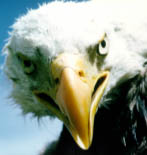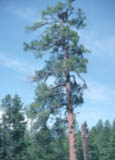

ATTENTION!
Luna Lake Bald Eagles Need Your Help!!
The U.S. Forest Service, the Arizona Game and Fish Department, and the other agencies of the Southwestern Bald Eagle Management
Committee are asking for the public's assistance to help with the bald eagle management efforts at Luna Lake. The following
pamphlet describes the significance of this breeding pair, and how you can help the success of this unique pair of bald eagles!
The First Known Breeding Pair in the White Mountains
Wintering bald eagles are frequently observed throughout the White Mountains from late fall to early spring, but the
Luna Lake pair were the first breeding pair documented away from central Arizona watersheds. Due to their occupancy
in this type of habitat, the Arizona Game and Fish Department expanded their search image throughout the state, and
discovered several breeding areas, not typical of those in central Arizona. Currently (2008), there are 53 known
pairs of bald eagles in Arizona, averaging 40 nestlings per year. We are confident, with the public's help, we can
continue to produce young at Luna Lake and throughout Arizona.
Significance of This Pair
Due to the success of the species nationwide, the U.S. Fish and Wildlife Service downlisted the bald eagle from
Endangered to Threatened in 1995. In 1999, the U.S. Fish and Wildlife Service considered delisting the species.
In 2007, the U.S. Fish and Wildlife Service delisted the species nationwide. In Arizona, we have shared this
success with an increase of 40 breeding areas since the species was listed in 1978.
However, to reach full recovery of the bald eagle in Arizona, there must be a constant flow of breeding
bald eagles into (immigration), and out of our population (emmigration) for genetic diversity. Currently,
all of the breeding bald eagles in central Arizona were hatched in Arizona. The Luna Lake male was our first
indication that immigration may be reoccurring after the population declines of the 1940s. Born in southeast
Texas in 1988, this male traveled over 800 miles to establish a breeding area in Arizona. Each nestling
produced by this male, increases our chance of genetic immigration into the isolated population of central Arizona.
How Can You Help?
Near the active nest, bald eagles are sensitive to the presence of human activity. This reaction can reduce
the success of the breeding attempt or cause failure. Along the Salt and Verde rivers near the Phoenix
metropolitan area, high recreation levels in conjunction with impacts from development, threaten the success
of breeding attempts. Members of the Southwestern Bald Eagle Management Committee have implemented management
efforts to counteract those threats, while educating the public on the importance of their cooperation
Tips
- Keep your distance! The U.S. Forest Service has placed a Seasonal Breeding Area Closure around the nest area.
The area delineated by the posted maps, and marked by the signs and fencing, is closed to all entry from January
1 through June 30 annually. By remaining out of the closure, the adults can continue their normal breeding behavior
to successfully produce young. Any deviation from their normal behavior will cause the adult bald eagles to spend
additional energy to pay attention to intruders, which may effect the success of the breeding attempt. Arizona
Bald Eagle Nestwatch Contractors are on site to help protect the eagles and educate the public.
- Because the eagles do almost all their hunting on Luna Lake, they are very easy to watch. But because Luna
Lake is so small, the adult pair needs all the available opportunities to them to capture prey. Outside of the
closure, avoid approaching within 200 feet of perched bald eagle. If you use binoculars and watch from the boat
ramp, the eagles will put on a pretty good show! Coots and fish are favorite prey items.
- Anglers, beware of discarding fishing line along the shore and use the proper test fishing line. Two eaglets
have died in Arizona from being tangled in fishing line, and 50 percent of Arizona's bald eagle breeding areas
have had fishing tackle and/or monofilament removed from the nest. Fishing line has entangled the adult male at
Luna Lake, and is removed from the nest annually. Fishing line and tackle enters the nest from an adult
capturing prey that has broken the line and died, or by picking up discarded fishing line as nest material.
LUNA LAKE BALD EAGLE FACTS:
| Discovered: |
March 11th, 1994. |
| Success: |
18 young have successfully fledged since 1994. |
| Breeding Pair: |
Male is 20 years old. The female is at least 17 years old |
| Incubation: |
Begins is January or February, and normally lasts 35 days. |
| Nestlings: |
Hatch in February and March, and remain in the nest for 12 weeks. |
| Fledging: |
First flight is attempted in May or June. |
| Juveniles: |
Remain in the breeding area for 45 days before they migrate
north to the trout and salmon runs in the northern states. |
| Adults: |
Eagles typically begin breeding at 5 years old. |
Harassment
Intentional harassment of bald eagles punishable by federal law (The Bald and Golden Eagle Protection Act and The
Migratory Bird Treaty Act). Fines can total up to $25,000.00 and may included mandatory jail time. If you witness
any bald eagle harassment, or if you discovery an injured or dead bird, call the Alpine Ranger District:
(928) 339-4384, the Arizona Game and Fish Department's Region I office in Pinetop: (928) 367-4281 or Operation
Game Thief: (800) 352-0700.

